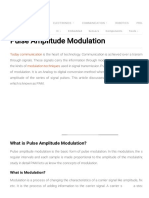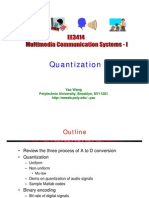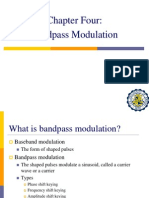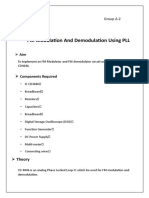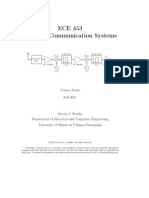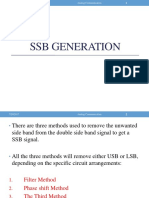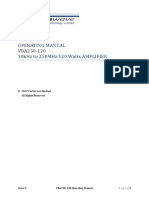Military College of Signals (Nust)
Uploaded by
saadmcsMilitary College of Signals (Nust)
Uploaded by
saadmcsMILITARY COLLEGE OF SIGNALS (NUST)
ASSIGNMENT NO 1
ADVANCED DIGITAL COMMUNICATIONS
SUBMITTED TO Sir , Dr. Imran Rasheed SUBMITTED BY Saad Mustafa Saeed MSEE-17 Dated:Feb,28th,2012
What is Line Coding?
In telecommunication, a line code (also called digital baseband modulation, also called digital baseband transmission method) is a code chosen for use within a communications system for baseband transmission purposes. Line coding is often used for digital data transport. Binary 1s and 0s, such as in PCM signaling, may be represented in various serialbit signaling formats called line codes.
>> Why Line Coding?
There are many reasons for using line coding. Each of the line codes you will be examining offers one or more of the following advantages:
Spectrum Shaping and Relocation without modulation or filtering. This is important in telephone line applications, for example, where the transfer characteristic has heavy attenuation below 300 Hz. Bit clock recovery can be simplified. DC component can be eliminated; this allows AC (capacitor or transformer) coupling between stages (as in telephone lines). Can control baseline wander (baseline wander shifts the position of the signal waveform relative to the detector threshold and leads to severe erosion of noise margin). Error detection capabilities. Bandwidth usage; the possibility of transmitting at a higher rate than other schemes over the same bandwidth.
At the very least the LINE-CODE ENCODER serves as an interface between the TTL level signals of the transmitter and those of the analog channel. Likewise, the LINE-CODE DECODER serves as an interface between the analog signals of the channel and the TTL level signals required by the digital receiver.
>> Most Popular Line Codes
Some of the most popular line codes are shown below.
The line codes shown above are also known by other names: Polar NRZ: Also called NRZL where L denotes the normal logic level assignment Bipolar RZ: Also called RZAMI, where AMI denotes alternate mark (binary 1) inversion Bipolar NRZ: Also called NRZM, where M denotes inversion on mark (binary 1)
>> Two Major Categories of Line Coding
There are 2 major categories: returntozero (RZ) and nonreturntozero (NRZ). With RZ coding, the waveform returns to a zerovolt level for a portion (usually onehalf) of the bit interval.
>> Further Classification
The waveforms for the line code may be further classified according to the rule that is used to assign voltage levels to represent the binary data. 1) Unipolar Signalling: In positivelogic unipolar signaling, the binary 1 is represented by a high level (+A volts) and a binary 0 by a zero level. This type of signaling is also called onoff keying (OOK). 2) Polar Signaling: Binary 1s and 0s are represented by equal positive and negative levels 3) Bipolar (Pseudoternary) Signaling: Binary 1s are represented by alternating positive or negative values. The binary 0 is represented by a zero level. The term pseudoternary refers to the use of 3 encoded signal levels to represent twolevel (binary) data. This is also called alternate mark inversion (AMI) signaling. 4) Manchester Signaling: Each binary 1 is represented by a positive halfbit period pulse followed by a negative halfbit period pulse. Similarly, a binary 0 is represented by a negative halfbit period pulse followed by a positive halfbit period pulse. This type of signaling is also called splitphase encoding.
>> Properties of Line Codes
Each line code has advantages and disadvantages. For example, the unipolar NRZ line code has the advantage of using circuits that require only one power supply, but it has the disadvantage of requiring channels that are DC coupled (i.e. with frequency response down to f = 0), because the waveform has a nonzero DC value. The polar NRZ line code does not require a DC coupled channel, provided that the data toggles between binary 1s and 0s often and that equal numbers of 1s and 0s are sent. However, the circuitry that produces the polar NRZ signal requires a negative voltage power supply as well as the positive voltage power supply. The Manchester NRZ line code has the advantage of always having a 0 DC value, regardless of the data sequence, but it has twice the bandwidth of the unipolar NRZ or polar NRZ code because the pulses are half the width.
>> Desirable Properties of a Line Code
SelfSynchronisation: There is enough timing in formation built into the code so that bit synchronisers can extract the timing or clock signal. A long series of binary 1s or 0s should not cause a problem in time recovery. Low Probability of Bit Error: Receivers can be designed that will recover the binary data with a low probability of bit error when the input data is corrupted by noise or ISI. A Spectrum that is Suitable for the Channel: For example, if the channel is AC coupled, the PSD of the line code signal should be negligible at frequencies near 0. In addition, the signal bandwidth needs to be sufficiently small compared to the channel bandwidth, so that ISI will not be a problem. Transmission Bandwidth: This should be as small as possible. Error Detection Capability: It should be possible to implement this feature easily by the addition of channel encoders and decoders, or the feature should be incorporated into the line code.
>> Differential Coding
When serial data is passed through many circuits along a communication channel, the waveform is often unintentionally inverted (i.e. data complemented). This result can occur in a twisted pair transmission line channel just by switching the 2 leads at a connection point when a polar line code is used. (Note: such switching would not affect the data of a bipolar signal) To eliminate this problem differential encoding is often employed. Each digit in an differential encoded sequence is obtained by comparing the present input bit with the past encoded bit. A binary 1 is encoded if the present input bit and past encoded bit are of opposite state. A binary 0 is encoded if the states are the same. Differential coding is often used with Manchester coding. The diagram below shows Manchester coding and differential Manchester coding for a sequence of bits.
You might also like
- EEE 4309C Lab 4 Common Emitter Amplifiers Lab Report100% (4)EEE 4309C Lab 4 Common Emitter Amplifiers Lab Report15 pages
- PSD of Pulse Coding Techniques With MatlabNo ratings yetPSD of Pulse Coding Techniques With Matlab7 pages
- 111ec0179 - Vishal Mishra - Baseband Transmission TechniquesNo ratings yet111ec0179 - Vishal Mishra - Baseband Transmission Techniques8 pages
- Pulse Amplitude Modulation (PAM) - Working, Types & Its Applications100% (1)Pulse Amplitude Modulation (PAM) - Working, Types & Its Applications15 pages
- Vi Sem Ece Simulation Practical Lab Manual (Diploma "L" Scheme Lab Manual) S.No Name of The Experiment Page NoNo ratings yetVi Sem Ece Simulation Practical Lab Manual (Diploma "L" Scheme Lab Manual) S.No Name of The Experiment Page No24 pages
- Pulse Code Modulation (PCM) .: Basic Elements of PCMNo ratings yetPulse Code Modulation (PCM) .: Basic Elements of PCM2 pages
- Question Bank: Information Coding TechniquesNo ratings yetQuestion Bank: Information Coding Techniques10 pages
- Department of E.C.E.: Digital Communications Lab ManualNo ratings yetDepartment of E.C.E.: Digital Communications Lab Manual29 pages
- Analog Communications: BY P.Swetha, Assistant Professor (Units 1, 2 & 5) K.D.K.Ajay, Assistant Professor (Units 3 & 4)No ratings yetAnalog Communications: BY P.Swetha, Assistant Professor (Units 1, 2 & 5) K.D.K.Ajay, Assistant Professor (Units 3 & 4)88 pages
- Unit 4 Bandpass Modulation and Demodulation100% (1)Unit 4 Bandpass Modulation and Demodulation107 pages
- Procedure: Introduction To SIMULINK AM Modulation and DemodulationNo ratings yetProcedure: Introduction To SIMULINK AM Modulation and Demodulation15 pages
- IIT - Project Report On Modulation (New-Main)0% (1)IIT - Project Report On Modulation (New-Main)32 pages
- Pulse Modulation: Powerpoint Templates Powerpoint Templates100% (1)Pulse Modulation: Powerpoint Templates Powerpoint Templates51 pages
- Angle / Exponential Modulation Lecture - 1: Dr. M. Venu Gopala Rao, Professor, Dept. of ECE, KL UniversityNo ratings yetAngle / Exponential Modulation Lecture - 1: Dr. M. Venu Gopala Rao, Professor, Dept. of ECE, KL University12 pages
- ELE 3203 Communication Systems: Student Name ID NumberNo ratings yetELE 3203 Communication Systems: Student Name ID Number16 pages
- Servomechnism and System Identifcation PDFNo ratings yetServomechnism and System Identifcation PDF23 pages
- Simulation of Digital Modulation Schemes Using MATLAB SimulinkNo ratings yetSimulation of Digital Modulation Schemes Using MATLAB Simulink17 pages
- 3.quantization and Transmission of AudioNo ratings yet3.quantization and Transmission of Audio10 pages
- 8255 (Programmable Peripheral Interface)No ratings yet8255 (Programmable Peripheral Interface)6 pages
- Line Coding: Lecture No. 9 Dr. Aoife Moloney100% (1)Line Coding: Lecture No. 9 Dr. Aoife Moloney27 pages
- Electron Spin Relaxation Near A Micron-Size Ferromagnet: Olume UmberNo ratings yetElectron Spin Relaxation Near A Micron-Size Ferromagnet: Olume Umber4 pages
- Asco 7000 Series 7atb, 7actb, 7adtb Automatic Transfer & Bypass-Isolation Switches G, Q, S, & U Design Installation ManualNo ratings yetAsco 7000 Series 7atb, 7actb, 7adtb Automatic Transfer & Bypass-Isolation Switches G, Q, S, & U Design Installation Manual16 pages
- Design of A Mobile Phone Charging Station Utilizing PV Renewable Energy SystemNo ratings yetDesign of A Mobile Phone Charging Station Utilizing PV Renewable Energy System17 pages
- DOB S.No. Subject Roll No. Marks Gender CommunityNo ratings yetDOB S.No. Subject Roll No. Marks Gender Community455 pages
- Effects of Magnetic Field On Micro FlameNo ratings yetEffects of Magnetic Field On Micro Flame125 pages
- EEE 4309C Lab 4 Common Emitter Amplifiers Lab ReportEEE 4309C Lab 4 Common Emitter Amplifiers Lab Report
- 111ec0179 - Vishal Mishra - Baseband Transmission Techniques111ec0179 - Vishal Mishra - Baseband Transmission Techniques
- Pulse Amplitude Modulation (PAM) - Working, Types & Its ApplicationsPulse Amplitude Modulation (PAM) - Working, Types & Its Applications
- Vi Sem Ece Simulation Practical Lab Manual (Diploma "L" Scheme Lab Manual) S.No Name of The Experiment Page NoVi Sem Ece Simulation Practical Lab Manual (Diploma "L" Scheme Lab Manual) S.No Name of The Experiment Page No
- Pulse Code Modulation (PCM) .: Basic Elements of PCMPulse Code Modulation (PCM) .: Basic Elements of PCM
- Department of E.C.E.: Digital Communications Lab ManualDepartment of E.C.E.: Digital Communications Lab Manual
- Analog Communications: BY P.Swetha, Assistant Professor (Units 1, 2 & 5) K.D.K.Ajay, Assistant Professor (Units 3 & 4)Analog Communications: BY P.Swetha, Assistant Professor (Units 1, 2 & 5) K.D.K.Ajay, Assistant Professor (Units 3 & 4)
- Procedure: Introduction To SIMULINK AM Modulation and DemodulationProcedure: Introduction To SIMULINK AM Modulation and Demodulation
- Pulse Modulation: Powerpoint Templates Powerpoint TemplatesPulse Modulation: Powerpoint Templates Powerpoint Templates
- Angle / Exponential Modulation Lecture - 1: Dr. M. Venu Gopala Rao, Professor, Dept. of ECE, KL UniversityAngle / Exponential Modulation Lecture - 1: Dr. M. Venu Gopala Rao, Professor, Dept. of ECE, KL University
- ELE 3203 Communication Systems: Student Name ID NumberELE 3203 Communication Systems: Student Name ID Number
- Simulation of Digital Modulation Schemes Using MATLAB SimulinkSimulation of Digital Modulation Schemes Using MATLAB Simulink
- Modulation and Coding Techniques in Wireless CommunicationsFrom EverandModulation and Coding Techniques in Wireless Communications
- Electron Spin Relaxation Near A Micron-Size Ferromagnet: Olume UmberElectron Spin Relaxation Near A Micron-Size Ferromagnet: Olume Umber
- Asco 7000 Series 7atb, 7actb, 7adtb Automatic Transfer & Bypass-Isolation Switches G, Q, S, & U Design Installation ManualAsco 7000 Series 7atb, 7actb, 7adtb Automatic Transfer & Bypass-Isolation Switches G, Q, S, & U Design Installation Manual
- Design of A Mobile Phone Charging Station Utilizing PV Renewable Energy SystemDesign of A Mobile Phone Charging Station Utilizing PV Renewable Energy System










